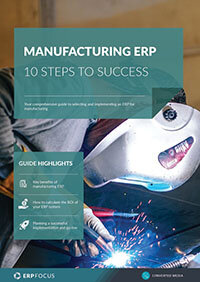Understanding ERP capacity planning for manufacturers
The biggest determinant of how much effort you put into your ERP system’s capacity planning capability is what your normal capacity situation is. If your factory is a one or two-shift operation, five days a week, and you can handle unexpected upsides or unforeseen problems with an occasional day of overtime then you probably do not want or need a complicated formal ERP capacity planning process. If, on the other hand, you attempt to run your assets on full 24/7, then capacity planning is a critical part of the everyday planning process, and some process – sophisticated or not – must be utilized so that people understand the capacity situation.
Recommended Reading: 10 Steps to Manufacturing ERP success - Find the right Manufacturing ERP for your business
An operational ERP system knows almost everything required to produce a capacity plan. The parts that are missing, however, are the details – often flexible choices – that can make ERP capacity planning difficult.
Bumps in the road
The first watch-out is the level of granularity. Typically, capacity planning occurs at the work center, or department level. If you have five identical machines grouped into a work center, then ERP would take all of the internal work orders, and compare them to the capacity of the five machines. That math is fairly clean. But what if the five machines are only similar, and not identical, and some products can only run on certain machines? Then you have the possibility of an individual machine bottleneck, while ERP says there is plenty of work center capacity.
The second watch out is that many organizations cannot articulate their change time relationships in terms of computer data. Specifically, going from A to B may require an hour of set up work, but going from A to C may require two hours of set up work, and going from B to C may require no downtime at all. If your ERP system associates a single change time with a work center, or a material, then you will start getting noticeably questionable output if you have a lot of changes.
An operational ERP system knows almost everything required to produce a capacity plan
Another bit of data that trips people up is when the time phased sequence of future internal work orders is not the way you actually intend to schedule your equipment.
The bottom line is that many supply chain and ERP professionals are initially excited about the potential of capacity planning in the ERP, but eventually conclude that the maintenance and constant tweaking of the module’s output outweigh the benefits. The more flexibility a manufacturing operation has in the way it assigns products to machines, or sequences orders for production, the harder it is to ensure accurate ERP output. In the end, you probably are not going to be able to use capacity planning to tell you whether you are two hours overscheduled on Machine 24 next week; you can use capacity planning to tell you whether you need to hire a third shift or not. Think through your process, use common sense math, and build consensus in your work group on the best way to get there.
Free white paper

Manufacturing ERP: 10 steps to success
Complete step-by-step guide to manufacturing ERP software

Featured white papers
Related articles
-

ERP capacity planning and scheduling
The different types of capacity planning and how this impacts scheduling
-

Secret KPI: Why Your ERP Implementation Team Matters More Than Software
Learn how Godlan ensures successful ERP implementation for manufacturers with proven strategies &...
-

4 training tips for manufacturing ERP success
These four training tips will help your employees get the most out of your new manufacturing ERP ...



